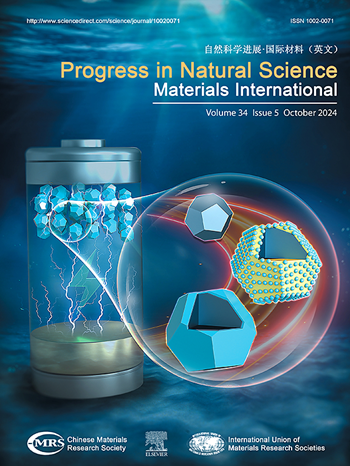基于机器学习的Fe-Si-B-P-C-Nb非晶/纳米晶合金的设计与制备
IF 7.1
2区 材料科学
Q2 MATERIALS SCIENCE, MULTIDISCIPLINARY
Progress in Natural Science: Materials International
Pub Date : 2025-04-01
DOI:10.1016/j.pnsc.2025.01.001
引用次数: 0
摘要
采用机器学习技术设计了一种新型的高软磁性能Fe-Si-B-P-C-Nb合金体系。首先,利用特征工程方法,通过卡方检验、Spearman相关和特征密度分析,分析了玻璃形成能力(GFA)、饱和磁通密度(Bs)和矫顽力(Hc)与元素特征的相关性,确定合金元素及其范围;利用极限梯度提升决策树(XGBoost)设计了Fe80.8+xSi0.2B14-xP2.25C2.25Nb0.5 (x = 0,1,2,3,4)的最优组合。最后利用单辊熔体纺丝、x射线衍射(XRD)、透射电镜(TEM)、振动样品磁强计(VSM)和直流B-H环示踪仪对所设计合金的物相和软磁性能进行了表征和测量。通过特征工程分析得到,添加约12个at。% B和少量的Nb、C和P (< 4% at.%)对GFA、Bs和Hc有显著的积极影响。结果表明,在712 K下退火150 s得到的Fe82.8Si0.2B12P2.25C2.25Nb0.5非晶和纳米晶合金的软磁性能分别为1.67 T和1.79 T, Hc为6.4 A/m和5.2 A/m,与预测值吻合较好。本文章由计算机程序翻译,如有差异,请以英文原文为准。
Design and preparation of novel Fe-Si-B-P-C-Nb amorphous /nanocrystalline alloys guided by machine learning
A novel Fe-Si-B-P-C-Nb alloy system with high soft magnetic properties was designed by machine learning. Firstly, the correlation between the glass formation ability (GFA), saturation magnetic flux density (Bs), and coercivity (Hc) with elemental features were analyzed by feature engineering to determine alloying elements and its ranges using chi-square test, Spearman correlation and feature density analysis. The optimal compositions Fe80.8+xSi0.2B14-xP2.25C2.25Nb0.5 (x = 0, 1, 2, 3, 4) were then designed by using the Extreme Gradient Boosting decision tree (XGBoost). The designed alloys, their phase and soft magnetic properties were finally prepared, characterized and measured by using the single roller melt spinning, X-ray diffraction (XRD), transmission electron microscopy (TEM) and vibrating sample magnetometer (VSM) and DC B-H loop tracer, respectively. It was obtained by the feature engineering analysis that the addition of approximately 12 at.% B and small amounts (<4 at.%) of Nb, C, and P showed a significant positive impact on the GFA, Bs, and Hc. It was indicated that the Fe82.8Si0.2B12P2.25C2.25Nb0.5 amorphous and nanocrystalline alloy obtained by annealing at 712 K for 150 s exhibited soft magnetic properties of 1.67 T and 1.79 T for Bs, 6.4 A/m and 5.2 A/m for Hc, respectively, were in good agreement with the predicted ones.
求助全文
通过发布文献求助,成功后即可免费获取论文全文。
去求助
来源期刊
CiteScore
8.60
自引率
2.10%
发文量
2812
审稿时长
49 days
期刊介绍:
Progress in Natural Science: Materials International provides scientists and engineers throughout the world with a central vehicle for the exchange and dissemination of basic theoretical studies and applied research of advanced materials. The emphasis is placed on original research, both analytical and experimental, which is of permanent interest to engineers and scientists, covering all aspects of new materials and technologies, such as, energy and environmental materials; advanced structural materials; advanced transportation materials, functional and electronic materials; nano-scale and amorphous materials; health and biological materials; materials modeling and simulation; materials characterization; and so on. The latest research achievements and innovative papers in basic theoretical studies and applied research of material science will be carefully selected and promptly reported. Thus, the aim of this Journal is to serve the global materials science and technology community with the latest research findings.
As a service to readers, an international bibliography of recent publications in advanced materials is published bimonthly.

 求助内容:
求助内容: 应助结果提醒方式:
应助结果提醒方式:


